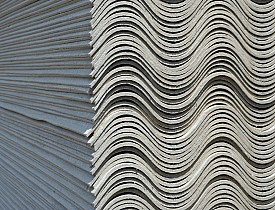Removing Asbestos
 Asbestos once seemed like a dream. The fire retardant insulator is versatile and ideal for various home, auto, and industrial products. However, health research found more of a nightmare. Asbestos is full of microscopic fibers that can break down and cause serious health problems when inhaled.
Asbestos once seemed like a dream. The fire retardant insulator is versatile and ideal for various home, auto, and industrial products. However, health research found more of a nightmare. Asbestos is full of microscopic fibers that can break down and cause serious health problems when inhaled.
Undisturbed, untouched asbestos should not pose problems, but the material is a hazard during remodeling or if damaged. Many asbestos products should be carefully covered or removed for your family's safety and certainly before trying to sell your house.
Why remediate asbestos?
Inhaling asbestos fibers most commonly causes lung tissue scars, which hinder the intake of oxygen in the blood and cause shortness of breath. The most fatal impact of asbestos exposure is lung cancer, though most cases are related to workplace exposure in asbestos manufacturing plants, not residential exposure. A second, more rare form of cancer is Mesothelioma, which spreads through lung, chest, abdomen, and heart membranes. Nearly all cases are linked to asbestos exposure, but it remains dormant for years.
Where Asbestos May Lurk
Many products made before the 1970s contain asbestos, including:
- insulation, particularly around pipes and ducts
- Shingles and siding
- Textured paint and joint spackle
- Fireproof fabrics on ironing boards, gloves, hot pads, etc.
- Rubber or vinyl floor tiles and backing
- Stove door gaskets
- Soundproofing foam
The mostly likely and most dangerous asbestos product in your home is insulation. If your insulation was installed between 1930 and 1950, have it tested for asbestos. Don't touch or disturb the asbestos. Have a professional sample the material and send it to a testing facility. A federal list of accredited asbestos laboratories is available at 301-975-4016 or here. This is particularly recommended before putting an older home on the market. A home inspector or buyer could suspect asbestos and want a certified bill of asbestos-free health to allay their concerns.
What to Do About Asbestos
You can't detect asbestos on sight alone. Don't touch suspected asbestos in good condition. Avoid touching or exposing your family to any damaged asbestos, and test any suspected asbestos before remodeling.
Hire somebody to test the asbestos, then somebody else to remediate. Otherwise, the testers may find overestimate the asbestos content to drive up their charges. Don't worry if the remediation doesn't actually remove all the asbestos. Professional repairs typically involve covering the material or applying a sealant that binds the fibers. Removal can be more expensive. Either way, don't try it at home. Leave it to the experts.
What Not to Do with Asbestos
Avoid dusting, sweeping, or vacuuming asbestos debris. Use a wet mop if you must walk through the area. Don't sand, scrape, or cut anything you suspect of containing asbestos. Don't use abrasive pads or brushes to strip asbestos flooring.
Asbestos is a health threat, and should be remediated for both your family's health and your home's resale value. Leave it to professionals, and don't worry if they cover the material instead of removing it.
Looking for a Pro? Call us (866) 441-6648

Roofing Average Costs
Roofers Experiences

Pool Wiring Repair Eliminates A Potential Hazard

Drywall Repair Drama: And The Leaks Went On And On



